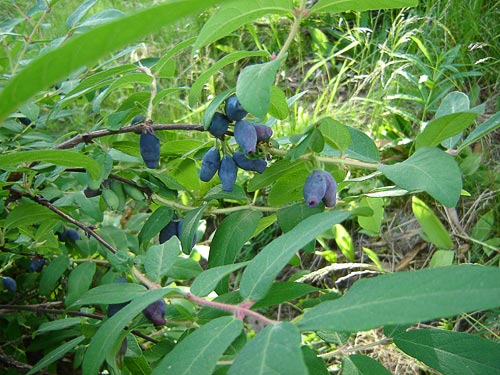Crops
Lonicera caerulea L. - Honeysuckle blue
Taxonomic position.
Family Capriofoliaceae Vant., genus Lonicera L.Synonyms.
Lonicera pyreniaca Pall., Caprifolium coeruleum Lam., Chamaecerasus coeruleum Delarbre, Xylosteum coeruleum Dum.-Cours.Biology and morphology.
This is a polymorphic tetraploid species. It is a fastigiate bush that is 1.0-1.8 m tall. Crown is plainly orbicular with 1.5-2.5 m diameter at 7-9 years of age. Coloring and pubescence of shoots depends on type. The bark exfoliates in longitudinal strips at 2-3 years of age. Root system is rachis-like, thick-growing. Leaves opposite, simple, smooth-edged, oval, length 3-5 cm, width 2-3 cm, pubescence on both sides, ciliate, dark green above, glaucous-green below. Many types have large discoid stipule, which do not fall with the leaves and instead remain dark, coriaceous and remain on branches for 1-2 years. Bisexual flowers in difloral inflorescence, auxiliary on drooping or horizontal peduncule; bracts 5-6 cm in length, calyx with short ciliate denticles, corolla pale yellow or greenish-white, tubuli funnel-shaped, 9-13 cm in length, 1-2 cm in diameter. Has a bottom ovary. Stamens are attached close to the edge of corolla, bilocular ovary, free, dense, enveloped by bractlets that have grown together. Compound fruit formed by mature bractlets cover two ovaries. The shape is orbicular, oval, cylindrical, surface smooth or bumpy in varying degrees. Fruit is neia-blue with a strong waxen bloom. Fruit length 12-40 mm, diameter 6-15 mm and weight 0.5-1.5 g. Fruit contains up to 20 seeds. Seeds are brown, ellipsoidal with fine-mesh surface; length is 2 mm. Weight of 1000 seeds 0.9-1.2 g. Fruit ripens in June-July. The plant fructifies at 3-4 years.Distribution.
The cultivation of honeysuckle in Russia started in the first half of the 18th century as an ornamental plant. Within berry cultivation it is a relatively young species. It was introduced into cultivation in Nerchinsk (East Siberia) in 1884. It is widely distributed within amateur gardening. There are industrial plantations in Western Siberia, on Altai, Ural, Middle Volga and in northwest Russia only. Northern border of distribution coincides with the northern border of agriculture. There are 17 zoned types in Russia. The most popular are as follows: Ivushka, Golubika, Rfgtkm, Rassvet, Pavlovsk, Amfora, Fialka, Goluboe vereteno, Nimfa, Morena, Sinitchka, Zolushka, and Vas'uganskaja.Ecology.
It is a typical mesophyte. It is shade-tolerant, slow-growing. It likes fresh and damp soil. Its growth conditions can vary greatly. It can survive a large range of soil acidity, from 3.9-7.7 (optimum 5.5-6.5). It is cold-resistant. Factors that limit its distribution in the south are warm winters, dryness of air and lack of soil moisture. For a good crop, it is necessary to plant 3-4 types together, as fruits are not formed when plants self-pollinate.Economic value.
Fruits contain 5-10% sugars, 1.5-4.5% acids, 0.4-0.8% pectin, vitamins C, A, B1, B2, B9 and D. Berries are used fresh for jam and compote. It is also used for medicinal purposes. The plant has a high decorative quality.Reference citations:
Grubov V.I., ed. 1986. Areas of trees and shrubs of the USSR. V. III. Leningrad: Nauka. 179 p.Lukshina V.V. 1990. Honeysuckle. Moscow.
Plekhanova M.N. 1998. Honeysuckle dark blue in a garden and in nursery. St. Petersburg: VIR. 64 p.
Pogiba S.P. 1987. Honeysuckle. Moscow: Agropromizdat. 47 p.
Skvortsov A.K., Kuklina A.G. 2002. Blue honeysuckle. Moscow: Nauka. 160 p.
Sokolov S.Ya., ed. 1962. Trees and shrubs of the USSR. V. 6. Moscow-Leningrad: Publisher of Academy of Sciences of the USSR. 379 p.
Vitkovsky V.L. 2003. Fruit Plants of the World. St. Petersburg-Moscow-Krasnodar: Lan'. 592 p.


